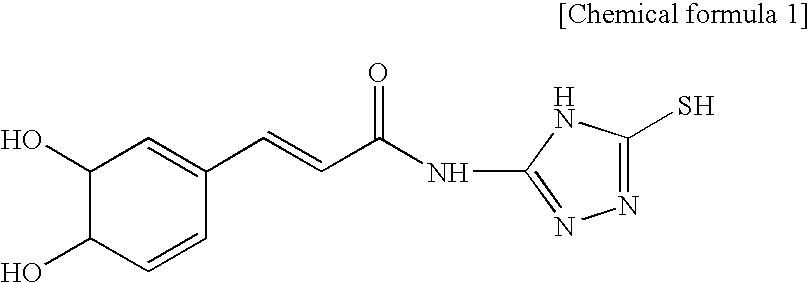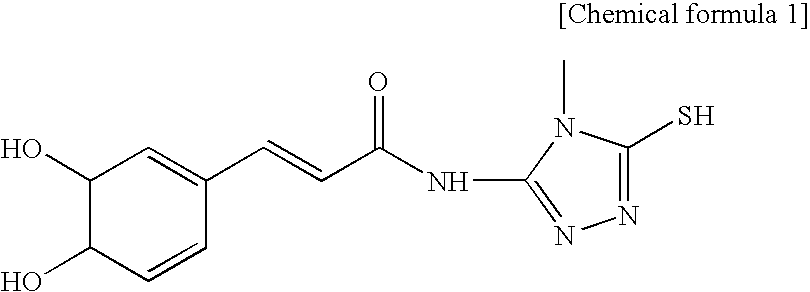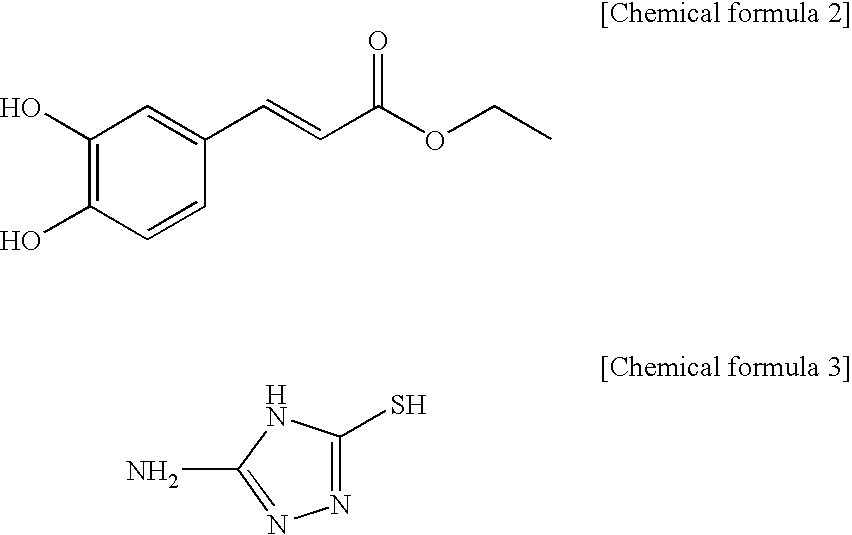Vitamin C composition stabilized with cationic material, anionic material and caffeic acid derivative
a technology of anionic material and vitamin c, which is applied in the field of vitamin c composition stabilized with anionic material and caffeic acid derivatives, can solve the problems of vitamin c oxide having a side-effect to damage the skin, losing its titer, and decomposition, and achieves stable vitamin c effect, and good anti-aging effect and whitening
- Summary
- Abstract
- Description
- Claims
- Application Information
AI Technical Summary
Benefits of technology
Problems solved by technology
Method used
Image
Examples
example of
PRODUCTION
[0058]
[0059]A caffeic ethylester denoted by the chemical formula 2 10 g is dissolved in ethanol 50 ml, a triazol derivate denoted by the chemical formula 3 5 g is applied, reflux stirring for 2 hours is performed and lastly it is cooled to the room temperature.
[0060]After strong hydrochloric acid 1 mL is applied, it is kept cool. By filtering the sediment and drying, the caffeic acid derivative 12 g (yield 80%) is achieved. By the result of the element analysis, it shows a proportions of “C 48.92 H 3.54 N 19.98 O 17.51; S 11.45” so that it is identified that the achieved caffeic acid derivative is the material (C11H10N403S1 (278.33): C 47.47 H 3.62 N 20.13 O 17.24 S 11.52) which satisfies the chemical formula 1.
example of experiment 1
[0061]In order to identify solubility of the caffeic acid derivative achieved by the production example, 1 mg / mL, 10 mg / Ml and 100 mg / mL of the caffeic acid derivative are dissolved respectively while purified water and ethanol are used as solvent. A caffeic acid (Sigma, US), as a contrast agent, is dissolved with the same density and the same solvent and compared. The purified water and ethanol was placed at the water bath before the experiment to maintain their temperature at 25° C. The result of the experiment 1 is shown in table 1.
[0062]
TABLE 1(the result of solubility measurement)solubilitysolventdensity (mg / mL)caffeic acidderivativecaffeic acidpurified water 1dissolvednot dissolved(25° C.)completely 10dissolvednot dissolvedcompletely100dissolvednot dissolvedcompletelyethanol (25° C.) 1dissolveddissolvedcompletelycompletely 10dissolveddissolvedcompletelycompletely100dissolvednot dissolvedcompletely
[0063]As shown in table 1, it can be understood that the caffeic acid derivative ...
example of experiment 2
[0065]In order to identify antioxidant activity of the caffeic acid derivative achieved by the production example, a free radical scavenging activity test was performed. The free radical scavenging activity test was a modified test of Kim et al. (Ko. J. Pharmacogn., 24(4), 299-303 (1993) and a reagent of DPPH (1,1-diphenyl-2-picryhydrazyl, Sigma company), as a stable free radical, was used.
[0066]150μ of the caffeic acid derivatives with various density are prepared. Those prepared caffeic acid derivatives are applied to 0.2 mM DPPH solution (when blank, ethanol is used), respectively and placed at the room temperature for 30 minutes. Experimental groups to test absorbency at 517 nm are established. Cases to use purified water are established as contrast groups. After measurement of absorbency with respect to the experimental groups and the contrast groups, elimination activation effect of free radical is achieved by using the equation 1 below. The result of the measurement is shown ...
PUM
| Property | Measurement | Unit |
|---|---|---|
| pH | aaaaa | aaaaa |
| pH | aaaaa | aaaaa |
| solubility | aaaaa | aaaaa |
Abstract
Description
Claims
Application Information
 Login to View More
Login to View More - R&D
- Intellectual Property
- Life Sciences
- Materials
- Tech Scout
- Unparalleled Data Quality
- Higher Quality Content
- 60% Fewer Hallucinations
Browse by: Latest US Patents, China's latest patents, Technical Efficacy Thesaurus, Application Domain, Technology Topic, Popular Technical Reports.
© 2025 PatSnap. All rights reserved.Legal|Privacy policy|Modern Slavery Act Transparency Statement|Sitemap|About US| Contact US: help@patsnap.com



